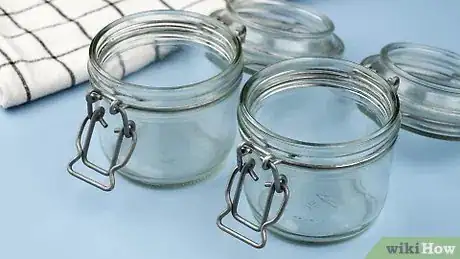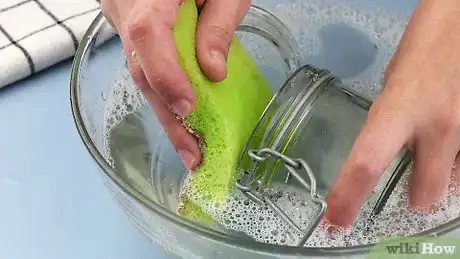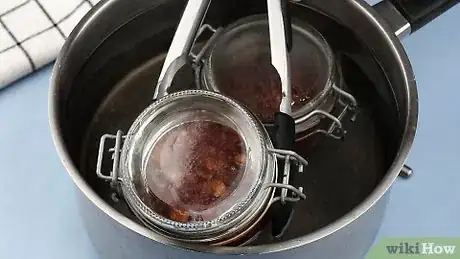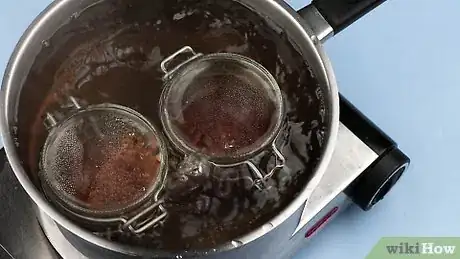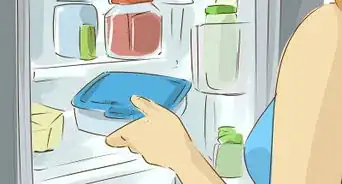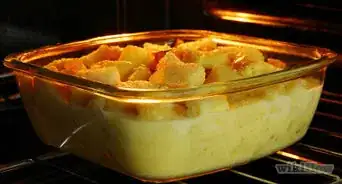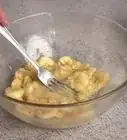wikiHow is a “wiki,” similar to Wikipedia, which means that many of our articles are co-written by multiple authors. To create this article, 16 people, some anonymous, worked to edit and improve it over time.
The wikiHow Culinary Team also followed the article's instructions and verified that they work.
This article has been viewed 318,159 times.
Learn more...
Fruit, vegetable, and meat preserves keep for a long time if properly prepared and canned. It's important to sterilize the jars and bottles before canning so that the food doesn't get contaminated with bacteria. See Step 1 to learn how to get your equipment ready by sterilizing it according to USDA standards.
Steps
Sterilizing Bottles and Jars
-
1Pick out appropriate glass jars and bottles. Look for jars or bottles designed for canning purposes. They should be made of tempered glass and free of nicks and cracks.[1] Be sure they each have appropriate tight-fitting lids.
- Jars should have flat, gasket-lined lids with screw bands. Screw bands can be reused, but you'll need new flat lids.
- Bottles should have rubber seals that are in good condition.
-
2Wash the jars and bottles. Use hot water and dish soap to thoroughly wash the jars and bottles you plan to sterilize. Make sure they are completely free of dried pieces of food and other debris. Wash the lids as well. They must be scrupulously clean.Advertisement
-
3Place equipment in a deep pot. Put the jars and bottles upright in the pot. Place the lid rings around the jars and bottles. Fill the pot with water until it covers the jars and bottles by 1 inch (2.5 cm).
-
4Boil the jars and bottles. Bring the water to a full, rolling boil. If you're at an altitude of less than 1,000 feet (304.8 m), boil them for 10 minutes. Add an additional minute for each additional 1,000 feet (304.8 m) of elevation.[2]
-
5Use tongs to remove the equipment from the water. One by one, lift the jars, bottles and lids and place them on a paper towel to dry. Be careful not to let the sterilized equipment touch anything except the clean paper towel.
Filling and Sealing the Jars and Bottles
-
1Fill the jars and bottles with the food you wish to preserve. Do this while the jars and the food are both still warm. Adding hot food to cold jars will cause the jars to crack.[3]
- Leave 1⁄4 inch (0.6 cm) of headroom at the top of each jar and bottle.[4]
- Wipe the rims of the jars and bottles to make sure food drops won't affect the seal.
-
2Place the lids on the jars and bottles. Screw on the lid rings and make sure the lids are securely fastened.
-
3Set the jars on a rack inside a deep pot. The wire rack will keep the jars from touching the bottom of the pot, helping the contents of the jar get evenly cooked and ensuring that the jar seals properly. Use a jar lifter to place the jars on the rack.[5]
-
4Boil the jars. Fill the pot with water until the jars are covered by 2 inches (5.1 cm). Boil the jars for 10 minutes, then remove them from the pot with a jar lifter and place them on paper towels.[6]
- Wait 24 hours before handling the jars. They should be completely cool before you put them into storage.
- Check the jar lids. A slight indentation in the flat lids shows that they have been properly sealed. If any of the lids are not indented, open the jars and use the contents instead of storing them.
Community Q&A
-
QuestionWhat household products can I use to sterilize bottles?
 Community AnswerIf they are glass or metal, the best way is to place them in boiling water.
Community AnswerIf they are glass or metal, the best way is to place them in boiling water. -
QuestionWill my glass bottle crack/break if I boil it?
 Community AnswerNo. Just be sure to avoid sudden changes in temperature. As long as you heat gradually and cool slowly, your glass will not break.
Community AnswerNo. Just be sure to avoid sudden changes in temperature. As long as you heat gradually and cool slowly, your glass will not break. -
QuestionHow long can I store DIY canned/sterilized bottled food before they go bad?
 Community AnswerIf the home canning is done properly (by following established standard practices as described in USDA publications or Ball Blue Book, for example), the food will last for many years without "going bad" in the sense of becoming unsafe to eat. It will, however, deteriorate in quality during that time. This depends to some extent on how it is stored, too. Canned peaches that are kept in the bright light of a windowsill will darken noticeably within months; it will develop off flavors as well. Stored in a cool dark place, a jar of peaches from the same batch could still taste fresh after a couple of years.
Community AnswerIf the home canning is done properly (by following established standard practices as described in USDA publications or Ball Blue Book, for example), the food will last for many years without "going bad" in the sense of becoming unsafe to eat. It will, however, deteriorate in quality during that time. This depends to some extent on how it is stored, too. Canned peaches that are kept in the bright light of a windowsill will darken noticeably within months; it will develop off flavors as well. Stored in a cool dark place, a jar of peaches from the same batch could still taste fresh after a couple of years.
References
- ↑ http://www.countryliving.com/cooking/about-food/sterilizing-canning-jars
- ↑ http://nchfp.uga.edu/how/can_01/sterile_jars.html
- ↑ http://www.countryliving.com/cooking/about-food/sterilizing-canning-jars
- ↑ http://www.marthastewart.com/267028/canning-tips
- ↑ http://www.marthastewart.com/267028/canning-tips
- ↑ http://www.marthastewart.com/267028/canning-tips
About This Article
To sterilize bottles and jars for canning, start by washing them with hot water and dish soap, including the lids. Then, place the bottles and jars upright in a deep pot and fill the pot with enough water to cover them. Once the pot is full of water, bring it to a boil and let the bottles and jars soak in the boiling water for at least 10 minutes. After 10 minutes, use tongs to remove the bottles and jars and set them on a paper towel to air dry. To learn how to fill and seal bottles and jars after you sterilize them, scroll down!
